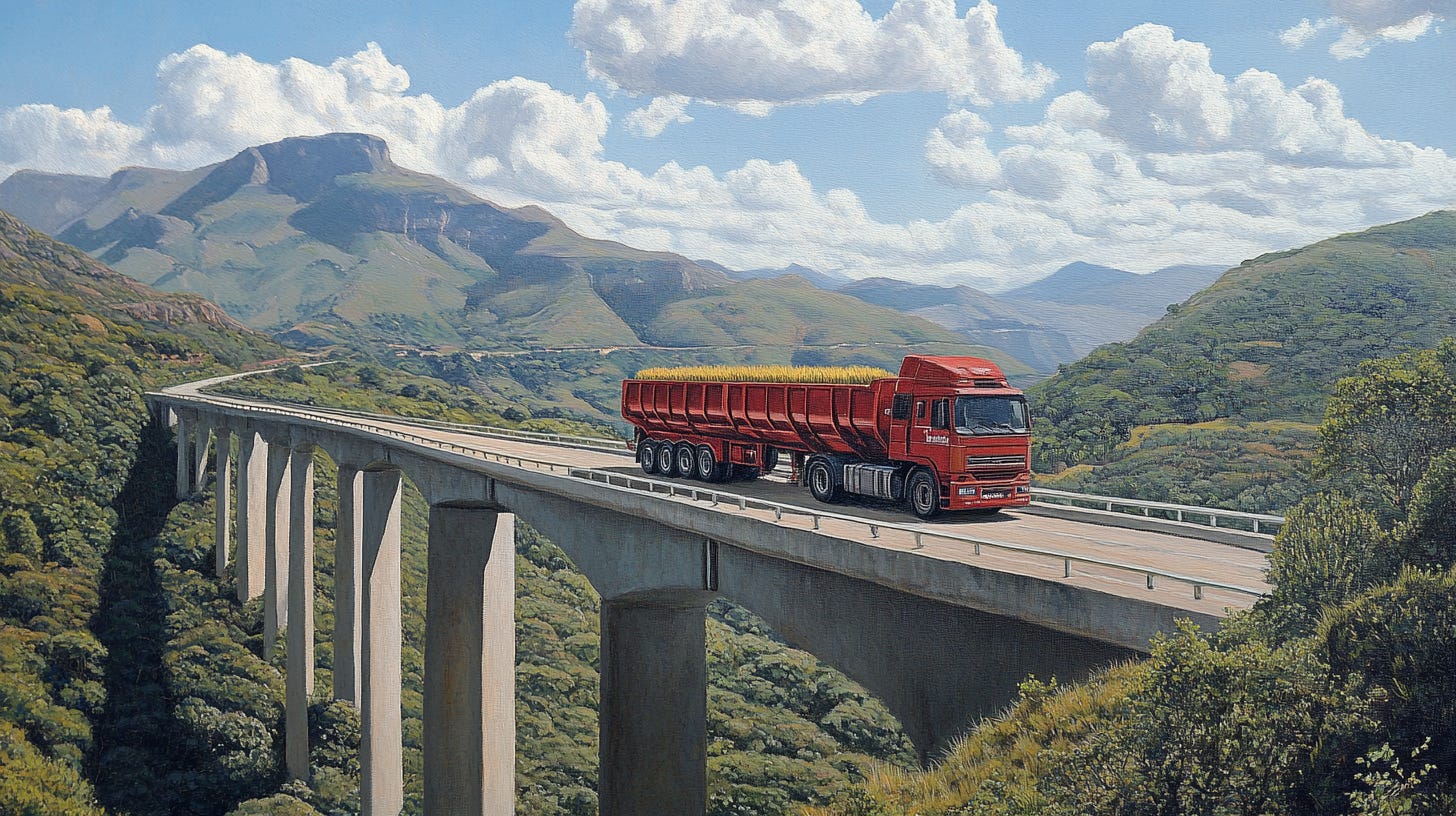In the early morning mist of the Transkei, Mlungisi stands on his modest patch of sandy soil. His maize struggles to grow, and his tools are old and worn. He works tirelessly, hoping to harvest enough to feed his family – and, if he’s lucky, to sell a little extra at a distant market.
But the odds are against him. His maize seeds have been passed down through generations, not scientifically developed for productivity, so his yields remain low. Without proper irrigation or fertiliser, his crops are unpredictable, entirely at the mercy of the weather. Even if he could produce a surplus, getting his maize to market would be a challenge – the dirt roads become impassable after heavy rains, and transport costs eat away at his already slim margins.
On top of it all, Mlungisi does not own the land he farms. Like his neighbours, he has only usage rights, granted by the chief who oversees the communal land. This system of land tenure is flexible, deeply rooted in Xhosa traditions, and embedded in networks of trust. It makes sense in a place where economic risk is high and social cohesion is essential. But it also traps Mlungisi in subsistence farming. Without formal ownership, he cannot use his land as collateral for a loan. He cannot invest in better tools or higher-yield seeds. His land rights provide security – but they also limit him.
Mlungisi’s story is not unique. It is the reality for millions of subsistence farmers across the Transkei and other former homelands in South Africa, where a third of the country’s population lives. And it serves as a stark reminder that property rights – often seen as the foundation of economic development – are neither fixed nor exogenous.
Last month, President Cyril Ramaphosa signed the Expropriation Bill into law, allowing the government to expropriate land without compensation under specific conditions. The signing reignited heated debates about land ownership, economic justice, and investment security, drawing both local and international attention. Global figures like former US President Donald Trump and Elon Musk warned of economic consequences, likening it to Zimbabwe’s land reforms. The Trump government even went as far as offering refugee status to Afrikaners, possibly, as I argued elsewhere, to attract Afrikaner farmers to America.
Yet for millions of subsistence farmers like Mlungisi, these debates are far removed from their daily realities. Their biggest obstacle to economic mobility isn’t expropriation – it’s the absence of formal property rights in communal land systems. This disconnect between high-profile land reform debates and the structural realities of communal land tenure exposes a deeper truth: land rights are not static but shaped by economic and technological conditions. They evolve in response to changes in production and market access rather than being imposed solely through legislation.
Let me explain. In economic theory, the production possibilities frontier (PPF) represents the maximum output a society can achieve with its available resources and technology. But the PPF is not fixed – it expands with innovation. Institutions, especially property rights, play a crucial role in this process. They determine who controls resources, who benefits from their use and what incentives drive investment and innovation.
Institutional economists like Douglass North have shown that land rights develop in response to economic constraints and opportunities. Secure property rights lower transaction costs, reduce uncertainty and allow markets to thrive. But these rights are not granted in isolation. Public choice theory reminds us that institutional change is often mediated by political interests, power struggles and elite self-interest. This is why property rights are frequently endogenous – they respond to changes in the economic environment but are also shaped by the distribution of power and resources.
In the Transkei, where market access is poor and crop yields are low, the communal land tenure system makes economic sense. It provides security in the face of risk, preserves social cohesion and reinforces the authority of traditional leaders. But this system also limits economic growth by discouraging investment and specialisation. A technological shock – such as improved infrastructure or higher-yield crops – could disrupt this equilibrium, expand the PPF, and encourage a shift toward a property rights system that prioritises surplus production. The Green Revolution offers a useful historical example of how such changes can unfold.
The Green Revolution refers to a technological transformation that reshaped agriculture in large parts of Asia and Latin America in the twentieth century. Higher-yield crop varieties, chemical fertilisers and improved irrigation dramatically boosted productivity, expanded the PPF and restructured rural economies. The initial shock was technological, but the institutional consequences were far-reaching. As the economic potential of farming expanded, the systems governing property rights – and thus the regulation of land and labour – also evolved.
Before the Green Revolution, most Indian farmers were trapped in a semi-feudal system, where exploitative tenancy agreements stifled innovation and discouraged investment – much like in today’s former homelands. High-yield crops required capital-intensive inputs such as fertiliser, irrigation and machinery, but tenant farmers lacked the security to make such investments. The Green Revolution triggered radical institutional change. As productivity soared, political pressure for land reform intensified. In regions like Punjab and West Bengal, land was redistributed, large estates were broken up and small-scale farmers gained greater security over their land. This allowed them to experiment with new technologies and further expand the PPF. But the process was uneven: in regions where landlords retained political power – either because the technological shock was not strong enough or because elites resisted change – reforms stalled, and the benefits of the Green Revolution remained concentrated among the wealthy.
In Pakistan, the Green Revolution’s impact on property rights was shaped by entrenched inequalities. Powerful landlords controlled the political system and were the primary beneficiaries of the new technologies. They had the capital to invest in high-yield crops, subsidised fertilisers and mechanisation. Tenant farmers, by contrast, were often excluded from these gains, lacking access to credit and inputs. The result was a reinforcement of existing land ownership structures, with large landowners consolidating their dominance over rural economies. Here, the PPF expanded, but political economy constrained its ability to benefit everyone.
In Mexico, the institutional impact of the Green Revolution was mediated by the ejido system, which allocated communal land to smallholder farmers. This system provided a degree of land security, enabling farmers to experiment with new technologies without severing ties to traditional governance structures. While the ejido system faced challenges – corruption, inefficiency and resistance to land redistribution – it illustrates how property rights can adapt to balance economic innovation with social cohesion.
What lessons can the Transkei draw from these experiences? Like pre-Green Revolution India, Pakistan and Mexico, the Transkei faces economic constraints that make its current property rights system rational. Communal land tenure provides security against risk and reinforces traditional authority, especially in areas where state support is weak. But this system also limits economic potential by restricting investment in productivity. Farmers like Mlungisi cannot invest in higher-yield crops or new technologies, and their access to markets remains severely constrained.
However, simply imposing property rights reforms from the outside is not a straightforward solution because it ignores the endogenous process through which property rights emerge and persist. Technological shocks could, instead, disrupt the status quo. In South Africa’s former homelands, improved infrastructure connecting rural towns to markets and the introduction of high-yield crop varieties could serve as such catalysts. These changes could create incentives for surplus production, potentially driving a re-evaluation of property rights.
Of course, there are risks. Infrastructure investments could turn into white elephants – many did under apartheid – if they are not accompanied by sustained economic activity and supporting services. Moreover, as India, Pakistan and Mexico have shown, political elites often determine how the benefits of such changes are distributed, sometimes capturing the surpluses for themselves while suppressing broader reforms. In South Africa, the ANC’s alliance with traditional leaders complicates matters further, as this relationship incentivises the preservation of communal land tenure and discourages investment in new technologies.
This is why the type of land reform Mlungisi needs – and, in truth, many others like him across South Africa and Africa – is unlikely to come from governments, local or foreign. Large leaps in technology and infrastructure are the most likely catalysts for creating demand for new property rights.
This is an edited and translated version of my monthly column, Agterstories, on Litnet. Special thanks to Kelsey Lemon for valuable research assistance. To support more writing like this, consider subscribing for a paid membership. The images were created using Midjourney.







For more than 10 years, I have worked in many parts of the Transkei (still a homeland) to try and promote regenerative agriculture. I often hear that local farmers are subsistence farmers because they lack property rights. But that’s not the complete story.
There are many families (including those from which I lease land in the Cacadu region) who own deeded land in the so called communal areas. They struggle to farm the land because it’s small (2 to 5 ha) which is consolidated with hundreds of other family plots of the same size which can only be farmed as one unit.
It’s impossible to farm a 2 ha plot without fencing, right size infrastructure, water and access to market (unless I grow soya beans and yellow maize). If farming 2 ha was possible and profitable, the land dispossession that resulted in black farmers being confined into the homelands would have never happened.
I also think it’s a myth that small scale farmers anywhere will ever be in a position to compete in commodity markets, farming small patches of land, with borrowed money, proprietary seed, big expensive shiny toys.
“Large leaps in technology and infrastructure are the most likely catalysts for creating demand for new property rights.” I agree wholeheartedly. But not just property rights, but also to encourage innovative alternatives to commodity agriculture.
I think it definitely matters how capital assesses risk in villages that operate on trust and openness within the community. Secondly heirloom seeds are vital as these reduce the capital outlay for farming; organic fertilisers must be encouraged to be produced at all villages….further reducing farming costs. Thirdly, the use of gmo seeds (foods) has a direct link to carcinogens.